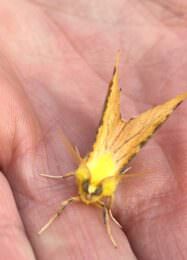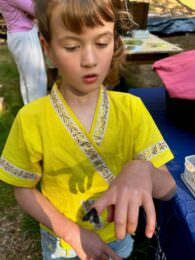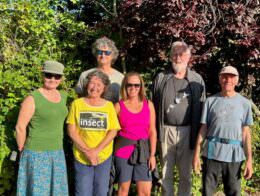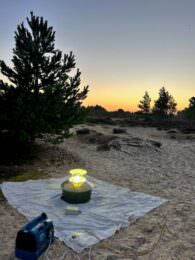 There was a very good turn-out for a mothing event last Sunday at Wilkies Wood, Park Ecovillage Findhorn. The event was hosted by local charity the Findhorn Hinterland Trust, who manage around thirty hectares of land adjoining the Ecovillage.
There was a very good turn-out for a mothing event last Sunday at Wilkies Wood, Park Ecovillage Findhorn. The event was hosted by local charity the Findhorn Hinterland Trust, who manage around thirty hectares of land adjoining the Ecovillage.
Experts from Butterfly Conservation and the Species on the Edge project deployed nine moth traps on the dunes overnight. Moths were then viewed in the woodland on a beautifully sunny morning, before being carefully released unharmed back into their habitat.
The dunes at Findhorn are nationally important for rare plants and insects, supporting over four hundred species of moths. Despite it being an unseasonably cold night there was a surprisingly large catch of the moths, with over fifty species recorded, including striking species like the Canary-shouldered Thorn.
 Pete Moore, Chair of the Highlands and Islands branch of Butterfly Conservation, explained how moths are undergoing dramatic declines due to habitat loss, but also how moths new to the area appear each year, due to our changing climate. Pete said: “I always wake up with a sense of excitement after trapping for moths at a new site, like a child on Christmas morning. I was delighted to see two species for the first time ever for me!”
Pete Moore, Chair of the Highlands and Islands branch of Butterfly Conservation, explained how moths are undergoing dramatic declines due to habitat loss, but also how moths new to the area appear each year, due to our changing climate. Pete said: “I always wake up with a sense of excitement after trapping for moths at a new site, like a child on Christmas morning. I was delighted to see two species for the first time ever for me!”
The Species on the Edge project is a partnership of conservation organisations working to protect the most biodiverse coastal sites in Scotland. The Project raises the profile of these places and works with communities to restore threatened habitats, including through scrub removal. Tracy Munro, Project Officer for the East Coast, explained how places like Findhorn dunes are the last refuge for some of our most threatened species. Tracy said: “Linking special wildlife sites along the coast is key to securing the future for some of our rarest species. Moths aren’t just found in special places though. Gardens are also great for moths. Getting a closer look is as simple as hanging-up a white sheet overnight and getting up early the next day to see what you’ve got. It’s great fun and very addictive!”
 Hinterland Trust Chair, Jonathan Caddy, described how he grew up playing on the dunes as a child and how being surrounded by nature there had inspired him to go on to study ecological science at Edinburgh University, saying: “Events like this are a fantastic way to inspire the next generation of people who will take care of our natural environment. It’s a real privilege to be able to give back to a landscape which has given me so much.”
Hinterland Trust Chair, Jonathan Caddy, described how he grew up playing on the dunes as a child and how being surrounded by nature there had inspired him to go on to study ecological science at Edinburgh University, saying: “Events like this are a fantastic way to inspire the next generation of people who will take care of our natural environment. It’s a real privilege to be able to give back to a landscape which has given me so much.”

Ecologist Sean Reed explained that the Hinterland Trust is embarking on a dune ecosystem restoration project, starting this November. The project will convert half a hectare of dense gorse into pristine bare sand. Sean said: ”The aim is to connect-up the few remaining refuges of high quality dune heath habitats and restart the natural process of wind-blown sand in these areas. The work may appear to be destructive while it is taking place, but it is a vital part of our wildlife conservation work and the land will very quickly take-on a natural appearance afterwards.”
Sean Reed
Ecologist

















FINDHORN HINTERLAND TRUST MOTHING EVENT SUNDAY 1st SEPTEMBER
Experts from Butterfly Conservation and the Species on the Edge project deployed nine moth traps on the dunes overnight. Moths were then viewed in the woodland on a beautifully sunny morning, before being carefully released unharmed back into their habitat.
The dunes at Findhorn are nationally important for rare plants and insects, supporting over four hundred species of moths. Despite it being an unseasonably cold night there was a surprisingly large catch of the moths, with over fifty species recorded, including striking species like the Canary-shouldered Thorn.
The Species on the Edge project is a partnership of conservation organisations working to protect the most biodiverse coastal sites in Scotland. The Project raises the profile of these places and works with communities to restore threatened habitats, including through scrub removal. Tracy Munro, Project Officer for the East Coast, explained how places like Findhorn dunes are the last refuge for some of our most threatened species. Tracy said: “Linking special wildlife sites along the coast is key to securing the future for some of our rarest species. Moths aren’t just found in special places though. Gardens are also great for moths. Getting a closer look is as simple as hanging-up a white sheet overnight and getting up early the next day to see what you’ve got. It’s great fun and very addictive!”
Ecologist Sean Reed explained that the Hinterland Trust is embarking on a dune ecosystem restoration project, starting this November. The project will convert half a hectare of dense gorse into pristine bare sand. Sean said: ”The aim is to connect-up the few remaining refuges of high quality dune heath habitats and restart the natural process of wind-blown sand in these areas. The work may appear to be destructive while it is taking place, but it is a vital part of our wildlife conservation work and the land will very quickly take-on a natural appearance afterwards.”
Sean Reed
Ecologist